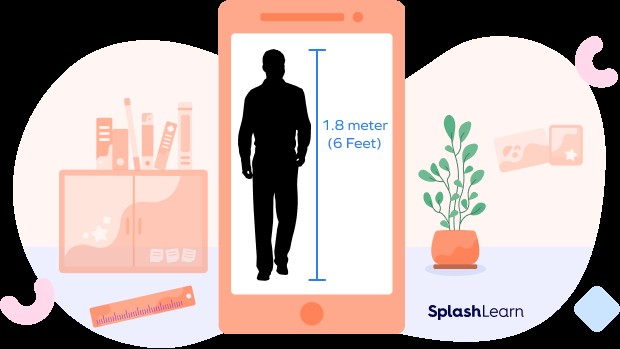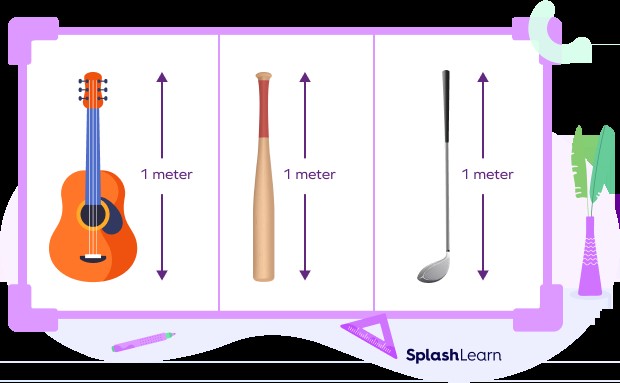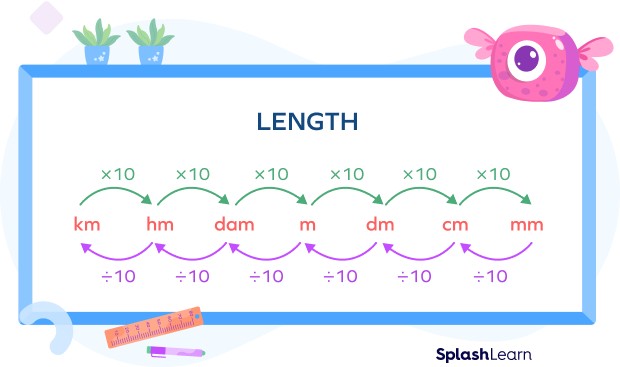The meter (m), a foundational unit in the International System of Units (SI), is used globally to measure length. But how long exactly is a meter? To truly grasp its length, it’s helpful to compare it to units you might be more familiar with, such as feet, yards, centimeters, and inches. This article will explore the definition of a meter, provide relatable examples, and delve into its conversions to other units of measurement, both within the metric system and in customary units. Understanding the meter is crucial for everyday measurements, scientific applications, and global communication.
Visual comparison of a meter’s length against the height of an average adult male, demonstrating its substantial size.
Defining the Meter: A Unit of Length
A meter, abbreviated as ‘m’, is the base unit of length in the metric system. Formally, it is defined as the length of the path traveled by light in a vacuum in 1⁄299,792,458 of a second. While this definition is incredibly precise and rooted in fundamental physics, for everyday understanding, we can think of a meter as:
- 100 centimeters (cm): Centimeters are commonly used for smaller measurements, and a meter comprises one hundred of them.
- 1,000 millimeters (mm): Millimeters are even smaller units, often used in engineering and precise measurements. A meter contains one thousand millimeters.
- One-thousandth of a kilometer (km): Kilometers are used for longer distances, and a meter is a thousandth part of a kilometer.
Within the metric system, converting between units is straightforward due to its decimal-based nature. Moving between meters, centimeters, millimeters, and kilometers simply involves multiplying or dividing by powers of 10.
Visualizing a Meter: Everyday Objects and Comparisons
To get a better sense of how long a meter is, consider these common objects that are approximately one meter in length:
- A Guitar: Most standard guitars are around 1 meter long, from the top of the headstock to the bottom of the body. This can be a helpful visual reference, especially for music enthusiasts.
- A Baseball Bat: The length of a typical baseball bat is close to 1 meter. Imagine holding a baseball bat – that length is roughly a meter.
- A Yardstick (Slightly Longer): While often used interchangeably in casual conversation, a yardstick is slightly shorter than a meter. A meter is approximately 3.37 inches longer than a yardstick.
- The Width of a Door: Standard interior doors are often around 0.8 to 0.9 meters wide. A wider door might be closer to a full meter.
- A Large Step: For an average adult, a reasonably large step is approximately one meter. Try taking a deliberate step and visualizing that distance.
- Height of a Young Child: An average 5-year-old child is often around 1 meter tall.
Visual examples of everyday items, such as a guitar and baseball bat, that approximate the length of one meter, aiding in practical comprehension.
Meter Conversions: Bridging Metric and Customary Systems
Understanding how meters relate to other units, particularly customary units like inches, feet, and yards, is essential for various applications. Here’s a breakdown of key conversions:
Metric System Conversions
The metric system is designed for easy conversions. Here’s how meters convert to other metric units of length:
-
Meter to Centimeter (m to cm): Since “centi” means one-hundredth, there are 100 centimeters in 1 meter.
- 1 m = 100 cm
- To convert meters to centimeters, multiply by 100. For example, 2 meters = 2 * 100 = 200 cm.
-
Meter to Millimeter (m to mm): “Milli” means one-thousandth, so there are 1,000 millimeters in 1 meter.
- 1 m = 1000 mm
- To convert meters to millimeters, multiply by 1000. For example, 0.5 meters = 0.5 * 1000 = 500 mm.
-
Meter to Kilometer (m to km): “Kilo” means one thousand. A kilometer is 1,000 meters.
- 1 km = 1000 m
- To convert meters to kilometers, divide by 1000. For example, 5000 meters = 5000 / 1000 = 5 km.
A visual chart illustrating the relationships between different metric units of length, emphasizing the decimal-based conversions.
Customary System Conversions
Converting meters to customary units (US customary units) involves slightly less round numbers but is still important for practical purposes, especially in countries like the United States.
-
Meter to Inches (m to in): 1 meter is approximately equal to 39.37 inches.
- 1 m ≈ 39.37 in
- To convert meters to inches, multiply by 39.37. For example, 1.5 meters ≈ 1.5 * 39.37 ≈ 59.055 inches.
-
Meter to Feet (m to ft): 1 meter is approximately equal to 3.28 feet.
- 1 m ≈ 3.28 ft
- To convert meters to feet, multiply by 3.28. For example, 2 meters ≈ 2 * 3.28 ≈ 6.56 feet.
-
Meter to Yards (m to yd): 1 meter is approximately equal to 1.09 yards.
- 1 m ≈ 1.09 yd
- To convert meters to yards, multiply by 1.09. For example, 10 meters ≈ 10 * 1.09 ≈ 10.9 yards.
Meter Conversion Chart for Quick Reference
| Conversion | Value |
|---|---|
| 1 meter to millimeters (m to mm) | 1000 mm |
| 1 meter to centimeters (m to cm) | 100 cm |
| 1 meter to inches (m to in) | ≈ 39.37 inches |
| 1 meter to feet (m to ft) | ≈ 3.28 feet |
| 1 meter to yards (m to yd) | ≈ 1.09 yards |
| 1 millimeter to meter (mm to m) | 0.001 m |
| 1 centimeter to meter (cm to m) | 0.01 m |
| 1 inch to meter (in to m) | 0.0254 m (exactly) |
| 1 foot to meter (ft to m) | 0.3048 m (exactly) |
| 1 yard to meter (yd to m) | 0.9144 m (exactly) |



The Importance and Global Relevance of the Meter
The meter’s significance extends beyond simple measurements. It is a cornerstone of the metric system, which is used by the vast majority of countries worldwide for science, commerce, and everyday life. The standardization provided by the meter facilitates:
- International Trade: Consistent measurements are vital for global commerce, ensuring products and dimensions are universally understood.
- Scientific Research: The metric system and the meter are essential in scientific fields for accuracy, reproducibility, and collaboration across borders.
- Engineering and Manufacturing: Precise measurements in meters and related metric units are crucial for engineering projects and manufacturing processes.
- Education: Teaching the metric system, with the meter as a base unit, provides a logical and coherent framework for understanding measurements.
Fun Facts About the Meter
- Historical Definition: Originally, in the late 18th century, the meter was defined as one ten-millionth of the distance from the equator to the North Pole along a meridian passing through Paris.
- Step Length: An adult’s average walking step is approximately 1 meter. This can be a useful, though rough, way to estimate distances.
- Prefix Power: The prefixes used with the meter (centi-, milli-, kilo-) are used with other SI units as well, making the metric system consistent and easy to learn.
Conclusion: Mastering the Meter
Understanding “How Long Is A Meter” is fundamental to grasping measurements in both metric and customary systems. By comparing it to familiar objects and exploring its conversions, you can develop a practical sense of its length. The meter’s role as a standard unit of length makes it indispensable in science, industry, and daily life across the globe. Whether you are calculating distances, working on a DIY project, or studying scientific concepts, a solid understanding of the meter is a valuable asset.
Solved Examples: Putting Meter Conversions into Practice
1. A table is 150 centimeters wide. What is its width in meters?
Solution:
Since 1 meter = 100 centimeters, to convert centimeters to meters, we divide by 100.
Width in meters = 150 cm / 100 = 1.5 meters.
Therefore, the table is 1.5 meters wide.
2. How many feet are there in 3 meters?
Solution:
We know that 1 meter ≈ 3.28 feet.
Number of feet in 3 meters = 3 meters * 3.28 feet/meter ≈ 9.84 feet.
So, 3 meters is approximately 9.84 feet.
3. Convert 2500 millimeters to meters.
Solution:
Since 1 meter = 1000 millimeters, to convert millimeters to meters, we divide by 1000.
Length in meters = 2500 mm / 1000 = 2.5 meters.
Thus, 2500 millimeters is equal to 2.5 meters.
4. Is 5 yards longer or shorter than 5 meters?
Solution:
We know that 1 meter ≈ 1.09 yards. Therefore, 5 meters is approximately 5 * 1.09 ≈ 5.45 yards.
Comparing 5.45 yards to 5 yards, we find that 5 meters is longer than 5 yards.
Frequently Asked Questions (FAQs) About the Meter
Q: Is a meter bigger than a yard?
A: Yes, a meter is slightly longer than a yard. 1 meter is approximately 1.09 yards.
Q: How many inches are in half a meter?
A: Half a meter is 0.5 meters. 0.5 meters * 39.37 inches/meter ≈ 19.685 inches. So, half a meter is approximately 19.685 inches.
Q: Why is the meter important?
A: The meter is the base unit of length in the metric system, used globally for science, trade, and standardization. It provides a consistent and easily convertible system of measurement.
Q: How was the meter originally defined?
A: Historically, the meter was defined based on the Earth’s dimensions – as one ten-millionth of the distance from the equator to the North Pole along a meridian through Paris. The modern definition is based on the speed of light for greater precision.
Q: What are some prefixes used with meters and what do they mean?
A: Common prefixes include:
- Centi- (c): one-hundredth (e.g., centimeter = 0.01 meter)
- Milli- (m): one-thousandth (e.g., millimeter = 0.001 meter)
- Kilo- (k): one thousand (e.g., kilometer = 1000 meters)
- Deci- (d): one-tenth (e.g., decimeter = 0.1 meter)
Q: Is the metric system easier to use than the customary system?
A: Many find the metric system easier because it is based on powers of 10. Conversions within the metric system are straightforward multiplications or divisions by 10, 100, 1000, etc., unlike the more complex conversion factors in the customary system (e.g., 12 inches in a foot, 3 feet in a yard, 5280 feet in a mile).
